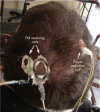Classification of intended phoneme production from chronic intracortical microelectrode recordings in speech-motor cortex
- PMID: 21629876
- PMCID: PMC3096823
- DOI: 10.3389/fnins.2011.00065
Classification of intended phoneme production from chronic intracortical microelectrode recordings in speech-motor cortex
Abstract
We conducted a neurophysiological study of attempted speech production in a paralyzed human volunteer using chronic microelectrode recordings. The volunteer suffers from locked-in syndrome leaving him in a state of near-total paralysis, though he maintains good cognition and sensation. In this study, we investigated the feasibility of supervised classification techniques for prediction of intended phoneme production in the absence of any overt movements including speech. Such classification or decoding ability has the potential to greatly improve the quality-of-life of many people who are otherwise unable to speak by providing a direct communicative link to the general community. We examined the performance of three classifiers on a multi-class discrimination problem in which the items were 38 American English phonemes including monophthong and diphthong vowels and consonants. The three classifiers differed in performance, but averaged between 16 and 21% overall accuracy (chance-level is 1/38 or 2.6%). Further, the distribution of phonemes classified statistically above chance was non-uniform though 20 of 38 phonemes were classified with statistical significance for all three classifiers. These preliminary results suggest supervised classification techniques are capable of performing large scale multi-class discrimination for attempted speech production and may provide the basis for future communication prostheses.
Keywords: chronic recording; locked-in syndrome; motor cortex; neurotrophic electrode; speech prosthesis.
Figures





References
-
- Birbaumer N., Ghanayim N., Hinterberger T., Iversen I., Kotchoubey B., Kubler A., Perelmouter J., Taub E., Flor H. (1999). A spelling device for the paralysed. Nature 398, 297–298 - PubMed
-
- Birbaumer N., Kubler A., Ghanayim N., Hinterberger T., Perelmouter J., Kaiser J., Iversen I., Kotchoubey B., Neumann N., Flor H. (2000). The thought translation device (TTD) for completely paralyzed patients. IEEE Trans. Rehabil. Eng. 8, 190–193 - PubMed
-
- Blakely T., Miller K. J., Rao R., Holmes M., Ojemann J. G. (2008). “Localization and classification of phonemes using high spatial resolution electrocorticography (ECoG) grids,” in Conference Proceedings of the IEEE Engineering in Medicine and Biology Society, 2008. 30th Annual International Conference of the IEEE EMBS 2008, Vancouver, August 20–24, 2008, 4964–4967 - PubMed
-
- Blankertz B., Krauledat M., Dornhege G., Williamson J., Murray-Smith R., Müller K.-R. (2007). “A note on brain actuated spelling with the Berlin brain-computer interface,” in Universal Access in Human-Computer Interaction. Ambient Interaction, ed. Stephanidis C. (Heidelberg: Springer; ), 759–768
Grants and funding
LinkOut - more resources
Full Text Sources
Other Literature Sources

